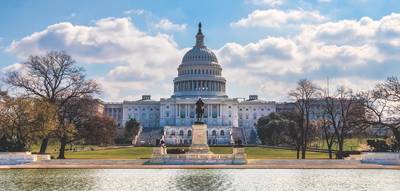The Federal Government’s 2020 Inland Impact
It is often difficult to push through the federal government morass to focus on the issues that actually matter to the inland operator. While 2020 inevitably will be a contentious year in American politics, it is critical to stay focused on the items that will have direct impact on the U.S. maritime industry. From a potential new Water Resources Development Act (WRDA) bill to potential Jones Act challenges, 2020 will be an important year for inland operators to stay politically engaged.
Work on WRDA
January marked the beginning of Congress’ work in earnest toward introducing a new WRDA bill. Congress has successfully passed WRDAs in 2014, 2016 and 2018, which authorized numerous studies and projects within the U.S. Army Corps of Engineers (Corps) Civil Works mission areas, to the benefit of U.S. inland operators.
On January 9, 2020, the House Subcommittee on Water Resources and Environment kicked off its work by holding a hearing on proposals for a new WRDA bill. In his opening statement, House Transportation and Infrastructure (T&I) Committee Chairman Peter DeFazio (D-Ore.) continued his call to unlock the existing $9.3 billion balance in Harbor Maintenance Trust Fund calling on his colleagues “to find the political courage to spend” the available funding. Chairman DeFazio’s bill seeking to open up the Harbor Maintenance Trust Fund (H.R. 2440) passed the House with bipartisan support in October, and remains under consideration by the Senate Committee on the Budget.
Hearing witnesses R.D. James, Assistant Secretary of the Army for Civil Works and LTG Todd Semonite, Chief of Engineers, highlighted the Administration’s focus on building partnerships between the Corps and non-federal stakeholders. Both witnesses pointed to reforms included in the President’s Fiscal Year (FY) 2020 budget proposal including the creation of an annual user fee. The proposed fee would supplement the current user-financed 50% share of inland waterway capital investments. Based on the witnesses’ testimony, it is reasonable to assume that the President’s FY 2021 budget, scheduled to be transmitted to Congress on February 10, 2020, will contain a similar proposal, which may become a central aspect of the WRDA 2020 discussion.
Following up on the hearing, on January 17, 2020, Chairman DeFazio joined other committee leaders in sending a letter to their Congressional colleagues urging them to finalize their priorities for WRDA 2020. The letter noted that the House T&I Committee will “soon be asking House Members to submit project, study, and policy requests for consideration in” a new WRDA bill. The letter further announced that the House Subcommittee on Water Resources and Environment will hold a Member Day hearing on WRDA requests on February 27, 2020. The Subcommittee expects to introduce and consider the WRDA bill later this year.
America’s Marine Highway Grants
In addition to a potential WRDA bill, 2020 promises to be an exciting year for America’s Marine Highway (AMH) projects. The year started off with a January 6 announcement by Secretary of Transportation Elaine Chao that the Maritime Administration (MARAD) was awarding $7.5 million in grants to nine AMH projects. The awards will support a wide range of projects on all U.S. coasts.
Additional financial support is on the way as the Further Consolidated Appropriations Act, 2020, which was signed into law on December 20, 2019, contained a further $9,775,000 in AMH program funding. This number, of course, represents a tiny portion of the total federal investment in our nation’s infrastructure, but nonetheless it should be welcome news that the AMH program continues to have solid bipartisan Congressional support. MARAD will likely issue a Notice of Funding Availability in the spring, given the timing of prior rounds. In the interim, inland operators should watch the President’s FY 2021 to see if it contains any funding requests for the AMH program. The President’s FY 2020 budget request zeroed out the program, but funding was restored through bipartisan Congressional efforts.
Challenges for Agricultural Exports
One area that clearly impacted inland operators in 2019 was the reduction in U.S. agricultural exports. For example, according the U.S. Department of Agriculture’s January 2, 2020 Grain Transportation Report, “the yearly total for barged grain was 23% lower than in 2018 and 28% lower than the average of the previous three years.” The report cited “poor navigation conditions due to flooding [that] slowed barge traffic, particularly through the locking portions of the Mississippi River.” Inevitably, however, a portion of the continued reduction was caused by ongoing trade tensions. For example, according to the American Farm Bureau Federation, “as a result of retaliatory tariffs” U.S. agricultural exports to China fell from $19.5 billion in 2017 to $9.1 billion in 2018.
It will be interesting to see how the President’s FY 2021 proposed budget responds to these continued reductions. In past years, the Administration has been unsupportive of established levels of federal support for agricultural exports. Indeed, the President’s FY 2020 budget proposal zeroed out established food aid programs, including the McGovern-Dole Food for Education Program and Title II Food Aid. These important programs provide not only a stabilizing base for American farmers, but also serve as a valuable source of cargo for inland carriers (and the U.S.-flag international fleet under cargo preference laws). Understanding the strategic importance of these programs, Congress restored $220 million in funding for the McGovern-Dole Food for Education Program and $1.725 billion in funding for Title II Food Aid under the Further Consolidated Appropriations Act, 2020.
The Dawn of VIDA
Additionally, 2020 looks to be the year that inland operators can finally participate in the development of the regulatory framework to implement the Vessel Incidental Discharge Act (VIDA). VIDA was welcomed by many inland operators when it was passed as part of the Frank LoBiondo Coast Guard Authorization Act of 2018, with the goal of replacing piecemeal federal, state and local vessel discharge regulations with uniform national standards. The Environmental Protection Agency (EPA) was directed under VIDA to promulgate federal standards of performance for marine pollution control devices for approximately 30 different categories of discharges incidental to the operation of vessels – including ballast water – by December 4, 2020. To meet this deadline (and legal public notice and comment requirements) maritime stakeholders can reasonably anticipate that the EPA will publish a Notice of Proposed Rulemaking requesting public comments in the coming months.
Jones Act Challenges
Finally, on June 5, 2020, the Jones Act (passed as part of the Merchant Marine Act of 1920) will reach its 100th anniversary. While marking this milestone, inland operators will need to remain vigilant as 2020 will undoubtedly continue the trend of challenges to the Jones Act. Sen. Mike Lee (R-Utah) currently has two bills under consideration by the Senate Commerce Committee that would destabilize the Jones Act. The Open America’s Waters Act of 2019 (S.694) would allow any vessel that meets “appropriate safety and security requirements” as determined by U.S. Coast Guard (USCG) regulations to operate in coastwise trade. In addition, the Protecting Access to American Products Act (S.1873) would allow for waivers of the Jones Act for “product carriers.” While it appears unlikely that either bill will emerge from Committee, the bills’ development should be closely watched by inland operators.















